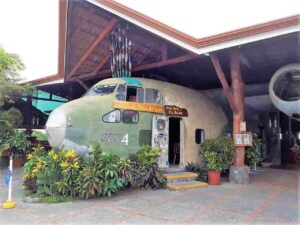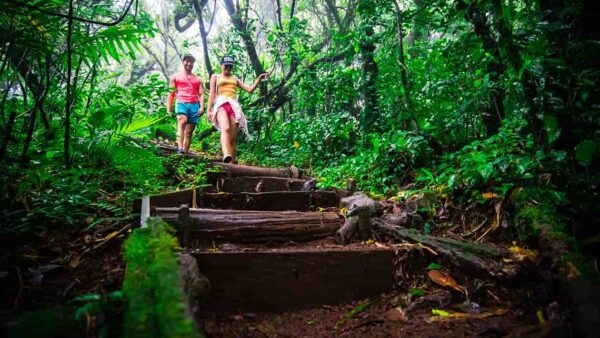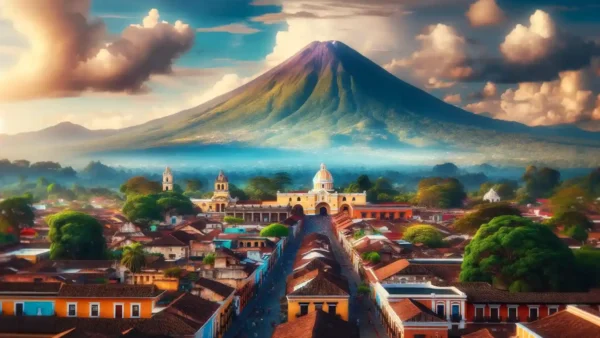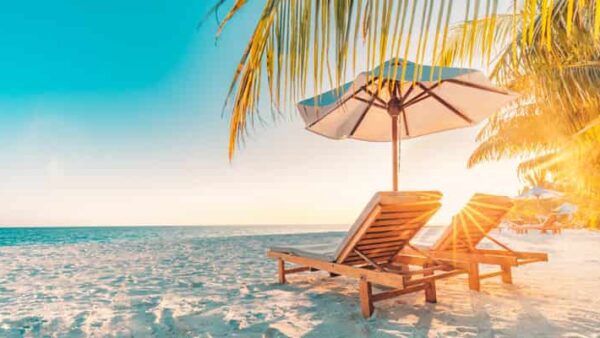Welcome to Parque Nacional Manuel Antonio, one of the top destinations in Costa Rica and one of our favorite spots in the country. Join us as we share our top tips for visiting Manuel Antonio, Costa Rica. Whether you are looking for inspiration, things to do in Manuel Antonio, or want some general advice on the area.
We share tips on where to stay, how to get around, and what activities and attractions are worth checking out. So whether you’re a first-time visitor or just looking for more information, this guide will help make your trip easier! you can contact them by phone: (506) 8671 1813 or email: tourguidepnma@gmail.com / maofficialtourguide@gmail.com
Parque Nacional Manuel Antonio is the biggest National Park in Costa Rica’s central Pacific coast. The park offers rainforest, white sand beaches, and coral reefs. It’s dedicated to its vast diversity of tropical plants and wildlife, including three-toed sloths, endangered white face monkeys, and hundreds of types of birds. The park is 680 hectares, with hiking trails and beautiful mountains.
Parque Nacional Manuel Antonio Park was established on 15 November 1972 and managed by the National System of Conservation Areas.
Typically, the best time to visit Parque Nacional Manuel Antonio is from the end of November to about April. That’s when the lowest amount of rain is in the area. Sometimes showers appear in March. So always be prepared, and the forecast is only occasionally correct. It might be raining all day, and it won’t rain, or it might say there’s no rain and it will rain, so be prepared for rain when it comes to the rainforest!
Manuel Antonio National Park is conveniently situated just a short drive from Quepos on the Pacific coast of Costa Rica. As of the time of filming, admission fees for non-locals were $16 per person, but they have now been updated to $18 per person.
Please note that only soda water and non-alcoholic drinks are allowed within the park premises. Bringing any type of food is strictly prohibited. However, if you find yourself hungry or thirsty, a snack bar near the beach is available.
The park is teeming with wildlife, so stay vigilant to spot animals and insects in unexpected places. The site is well-maintained, and some trails lead you deep into the dense Costa Rican jungle.
If you prefer tranquility, consider visiting Jimela’s Beach, a bit further out. You might have the beach to yourself due to its secluded location.
You’ll likely encounter the adorable white-faced capuchin monkeys. While they may seem cute, be cautious as they might attempt to take something from you when you least expect it. This behavior is precisely why food is not allowed in the park.
If you’re fortunate, you may catch a glimpse of the endangered and agile squirrel monkeys in action. Although somewhat shy, they are entertaining to watch, especially when making impressive long-distance jumps.
After exploring the humid jungle, take a refreshing swim at Manuel Antonio Beach in the Pacific Ocean. Keep an eye on your belongings, as white-faced monkeys are always nearby, hoping for a chance to snatch something.
Visiting Parque Nacional Manuel Antonio National Park, which is by far the biggest National Park in the whole country, so there are just a few things you need to keep in mind when visiting the park. First of all, you need to buy tickets online.
Parque Nacional Manuel Antonio Ticket Price
| Ticket Type | Ticket Price |
|---|---|
| Non-resident adult (over 12 years old) | $18.08 |
| Non-resident child (2 to 12 years old) | $5.65 |
| Resident adult (over 12 years old) | ¢ 1808 |
| Resident children (6 to 12 years old) | ¢ 565 |
| Resident children (under 6 years old) | ¢ 0 |
| Golden Citizen (nationals) | $ 0 |
| Non-resident child (0 to 2 years old) | $ 0 |
Note: Entry rates with VAT included: You need to go to the official website here, book tickets, and arrive here at the time of your ticket. Second of all, you cannot bring food into the park. They have security that would check your bags to make sure that you’re not bringing anything.
Third, get a guide. There are some tickets online that you can buy, where it’s 60 per person. We recommend getting a certified guide right outside the gate. You can usually barter for them between $50 to $100 for your group size.
They will take you on a one to two-hour tour down to the beach. Make sure you bring a bathing suit. Stunning beach there with super warm water, so bring a bathing suit and a change of clothes… and enjoy!
After you finish with the park, there’s still lots to do in Manuel Antonio. So first of all, the beach. Even though it’s a beautiful beach inside, there’s a beautiful beach outside with many things to do.
You can go surfing, and take some surfing lessons. You can go horseback riding, quad tours, and some parasailing goes out of here. There’s some jet skiing, you can walk around town. Check out some of the shops. There’s a lot to do here, but one of my favorite things is to go inland and check out some of the rainforest and, for that, go to Rainmaker.
So now let’s discuss about restaurants. There are plenty of restaurants here in Manuel Antonio, so you’ll never have to worry about cooking for yourself.
Now, you’ll find many local Costa Rican restaurants in town, close to Manuel Antonio National Park. So they serve typical Costa Rican foods: ceviche, casados, and whole fish. If you still need to try that cuisine, stop in one of those and have a feast.
After a day of trekking in Manuel Antonio National Park, consider stopping at El Avion Restaurant. While the food is relatively pricey, the unique experience of dining in a Cold War relic, the Fairchild C-123 airplane, makes it worthwhile. You can even climb into the cockpit of this historical aircraft.
Now, you’ll find slightly more upscale and exciting restaurants up the hill. Many of them have more excellent views, so they’re great to go for Sunset, and some offer something a little different. There’s a Moroccan and Middle Eastern restaurant available, a sushi place, a Thai place, and one of my favorite restaurants, a really cool place called EL Avion. Check it out because, as you can guess, it’s based inside an airplane.


Parque Nacional Manuel Antonio Attractions
Mangrove: Mangrove covers approx 18 hectares. The trails parallel to the Manuel Antonio and Espadilla Sur beaches can be observed. Mangrove consists of fresh and saltwater that covers red, Manuela, and knight mangrove species.
The Waterfall: the beautiful Waterfall available in this park only in the rainy season. This Waterfall is the most famous tourist attraction in this park.
Playa Gemelas: Playa Gemelas beach is divided in two by a rock formation that makes it possible to observe small stone fragments detached from the bedrock in its areas.
Manuel Antonio Beach: Manuel Antonio Beach is most famous for its natural beauty, golden sand, and water activities. Here, you can see a large amount of marine fauna and corals.
The Trap: The Trap is another tourist attraction that can see the right side of Manuel Antonio Beach next to Punta Catedral.
Espadilla Sur Beach: this beach is located in a bay with strong waves at some times of the year and is a less crowded destination. Espadilla Sur Beach is one of the Top Things to do in Costa Rica.
Frequently Asked Questions (FAQ) for Manuel Antonio National Park
Q1: What is Manuel Antonio National Park known for?
A1: Manuel Antonio National Park is renowned for its stunning biodiversity, pristine beaches, and lush rainforest. It’s one of the most popular national parks in Costa Rica, celebrated for its diverse flora and fauna.
Q2: What wildlife can I expect to see in Manuel Antonio National Park?
A2: The park is home to a variety of wildlife, including capuchin monkeys, howler monkeys, three-toed sloths, iguanas, and numerous bird species. Keep an eye out for colorful toucans and the endangered squirrel monkey.
Q3: Are there hiking trails in the park?
A3: Yes, Manuel Antonio offers several well-maintained trails. The most popular one is the main trail leading to beautiful viewpoints overlooking the Pacific Ocean. There are also trails leading to pristine beaches within the park.
Q4: Can I swim at the beaches in Manuel Antonio National Park?
A4: Yes, there are several gorgeous beaches within the park where swimming is allowed. However, it’s essential to follow safety guidelines and be cautious of strong currents.
Q5: Are guided tours available, and do I need one?
A5: Guided tours are available and can enhance your experience by providing insightful information about the park’s ecology and wildlife. While not mandatory, a guide can help you spot hidden creatures and learn more about the park.
Q6: Is there an entrance fee to Manuel Antonio National Park?
A6: Yes, there is an entrance fee, and it varies for foreigners, nationals, and children. It’s advisable to check the current fees before planning your visit.
Q7: What amenities are available within the park?
A7: The park has basic amenities, including restrooms, picnic areas, and snack vendors. It’s recommended to bring essentials like water, sunscreen, and comfortable clothing for your visit.
Q8: Can I bring food into the park?
A8: While there are designated picnic areas, it’s essential to be mindful of the park’s rules. Feeding wildlife is strictly prohibited, and visitors are encouraged to keep the park pristine by properly disposing of trash.
Q9: When is the best time to visit Manuel Antonio National Park?
A9: The dry season, from December to April, is generally considered the best time to visit when the weather is pleasant. However, the park attracts visitors year-round, and the lush greenery during the rainy season (May to November) can be equally captivating.
Q10: Are there any restrictions or rules I should be aware of?
A10: Yes, visitors are expected to follow park rules, such as staying on designated trails, not feeding wildlife, and respecting the natural environment. It’s crucial to be aware of and adhere to these regulations to preserve the park’s beauty and biodiversity.
We hope you enjoyed this guide and hope you stick around for more guides in the future!




